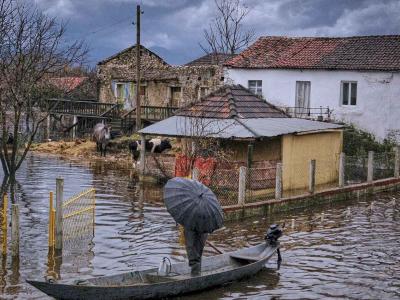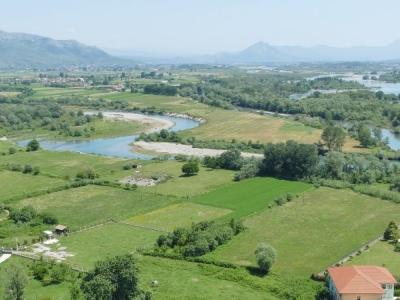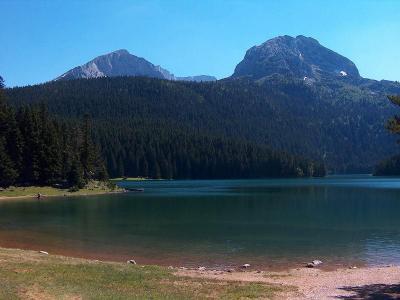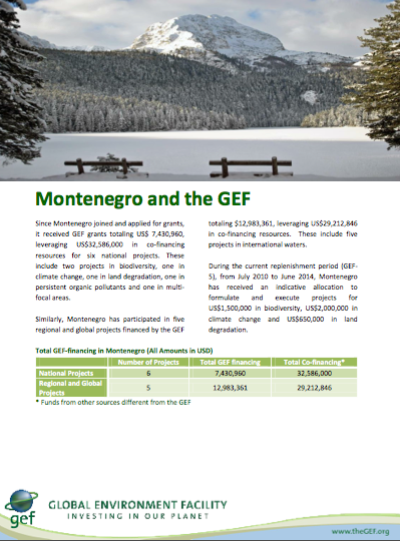Montenegro

Montenegro is a mountainous country in the Southeast Europe which regained its independence in 2006. The total length of its land borders is 614 km. The section of the Adriatic Sea coast in the country is 293 km long. The total surface of the state territory is 13,812 km2, and of the territorial sea approximately 2,540 km2.
Geographic Characteristics
The northern part of the country is dominated by high mountains, descending through a karst segment in the central part with large depressions/plains, to a coastal plain varying in width from several hundreds of meters to several kilometers. The lowest part of the central inland area are the valleys of the Zeta River and the lower Moraca River, comprising the Zeta-Bjelopavlići plain with the Lake Skadar, the largest lake in the Balkans. The mountain ranges in the north include 37 peaks with heights above 2,000 meters. The deepest canyon in Europe, the Tara River Gorge with a depth of up to 1,300 m, is also located in the northern mountainous region.
Climate
The southern region of Montenegro and the Zeta-Bjelopavlići plain have Mediterranean climate, with long, hot and dry summers and relatively mild, rainy winters. The central and northern regions of the country have certain characteristics of mountain climate, although the influence of the Mediterranean Sea is also evident. The continental climate in the far north is characterized by large daily and annual temperature ranges, in addition to low annual precipitation, rather evenly distributed over all months.The average annual air temperatures vary from approximately 15.80 C in the south to 4.60 C in Žabljak. The duration of the sunny periods varies from 2,400 to 2,600 hours per year on the coast, i.e. from 1,600 to 1,900 hours in the mountains. Annual precipitation is very uneven, ranging from approximately 800 mm in the far north to about 5,000 mm in the far south. On the slopes of Mount Orjen, at the village of Crkvice (940 m above the sea level), precipitation may even reach 7,000 mm in record years.
Land Use
Agricultural land covers approximately 5,145 km², which is 37% of the total country area; about 6,225 km² or 45% is covered by forests, while the settlements, roads, rocky areas and other categories encompass the remaining 2,442 km² or 18% of the total territory.
Water Resources
The water resources distribution and abundance vary significantly in Montenegro. Generally speaking, with an average annual runoff of 624 m3/s (i.e. the volume of 19.67 billion m3), the territory of Montenegro falls among the water rich areas.
Forests
Forests occupy approximately 620,000 hectares or 45% of the total land area, while non-overgrown forest land takes up another 123,000 hectares (9%). The forest cover ratio is 0.9 ha/person. An overall timber stock is estimated to about 72 million m3, out of which 29.5 million m3 or 41% are conifers, and 42.5 million m3 or 59% are deciduous trees.
Coastal Area
The coastal zone (six coastal municipalities) encompasses approximately 11% of the national territory. This region includes a zone designated as special purpose coastal area (public maritime domain – “morsko dobro”), which is a narrow coastal belt with the surface of approximately 60 km2, including inland waters and the territorial sea covering altogether approximately 2,540 km2.
Environment
Significant sources of air pollution are the main industrial and energy complexes using old technologies, which as a rule apply no adequate mitigation measures. The transport-related air pollution is increasing, especially in city centers. The air quality, evaluated from the aspect of global indicators, is satisfactory. For particular pollutants and at particular locations, it is necessary to take some pollution prevention measures. In addition to communal wastewater (which is mostly discharged into the natural recipients without prior treatment), untreated industrial wastewater and inadequately disposed waste also make a significant contribution to the pollution of water bodies. The quality of surface waters is generally assessed to be good, with occasional non-compliance with the prescribed standards. Montenegro has a very rich flora and fauna, as well as diverse ecosystems. With approximately 3,250 plant species, the country is viewed as one of the floristically most diverse regions of the Balkan Peninsula, whereas the species-to-area ratio of vascular plants is very high, amounting to 0.837. The total share of protected areas in the national territory is 9.21%, and it mainly refers to the five national parks. The data on the generated, collected, treated and disposed volumes of waste, as well as on specific waste streams, are either incomplete or entirely missing, so the planning of waste management is still largely based on estimates.
Source: Initial National Communication on Climate Change of Montenegro, 2010.







